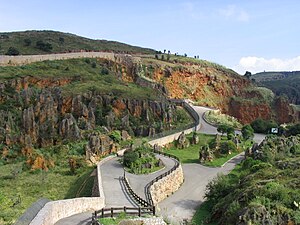bio.wikisort.org - Zoo
Cabárceno Natural Park (Parque de la Naturaleza de Cabarceno (Obregon)) is a zoo and nature reserve located in the town of Penagos, Spain, 17 kilometres (11 mi) south of Santander.[2]
This article needs additional citations for verification. (July 2020) |
 Park grounds | |
| Date opened | 1989 |
|---|---|
| Location | Penagos (Cantabria) |
| Coordinates | 43°21′00″N 3°51′08″W |
| Land area | 750 ha (1,900 acres) |
| No. of species | >112 |
| Memberships | EAZA[1] |
| Major exhibits | Raptors, sea lions |
| Website | www |
The park is located in a former open-pit iron mine on a karstic landscape consisting of 750 hectares.[3] It now belongs to Cantur, a tourism company owned by the government of Cantabria.
The Cabárceno Natural Park has two main purposes: the conservation of endangered species and environmental education.
Cabárceno Natural Park
The natural park of Cabárceno is a naturalised space reclaimed from 750 hectares (1,900 acres) of former open-pit mines and restored to the primitive beauty of the karst landscape.
The natural park is home to 100 animal species from five continents living in semi-captive conditions, including large enclosures where one or more species coexist.
Except for the food provided to them, the animals enjoy almost total freedom. Their environment and limited human interference allow the animals to live undisturbed as they would in the wild to promote a healthy ecosystem for all the species living in the zoo.

The park has more than 20 kilometres (12 mi) of roads as well as numerous parking areas and footpaths. The natural scenery of the park includes gorges, lakes, and rock formations.[4]
Reptiles
The reptile section is located at the entrance of the park, next to the café La Mina. Turtles, lizards, and several venomous snakes, such as cobras, rattlesnakes, and some species of giant snakes, can be found in this area of the zoo.
Animals
The park has many animal species, including:


- Addax
- Sable Antelope
- Zebra
- Grevy's zebra
- Pere David Deer
- Cobo lichi
- Coypu
- Dromedary
- Common Eland
- African Elephant
- Emu
- Warthog
- Fallow deer
- Gaur
- Western Lowland Gorilla
- Spotted hyena
- Hippo
- Pygmy hippopotamus
- Impala
- Jaguar
- Giraffe
- Lion
- Lynx
- Lycaon
- Wolf
- Mouflon
- Cantabrian brown bear
- Olive baboons
- White Rhinoceros
- Blue Wildebeest
- Tiger
- Cattle
- Rhea



Facilities
There are several facilities available at the park, including a nurse station, public phones, ATMs, environmental classrooms, picnic areas, parking areas, a cafeteria, a restaurant, and souvenir shops. There is also a gondola to transport people throughout the park.
- Los Osos is located in the heart of the park opposite the exhibition of ostriches and antelopes. There is a restaurant, cafeteria, and souvenir shop with snacks, sandwiches and drinks. It has a terrace with a bear enclosure in the background.

- La Cabaña is a cafeteria located near the environmental education classroom and has a capacity of 300 guests and a variety of food options.
- La Mina is a cafeteria located next to the reptile house at the main entrance of the park. It has a gift shop and terrace.
Botanical routes
Twenty-four of the 100 trees in the park are grown in some of the park's most visited places: the tiger, hyena, wolf and lion sections.
Botanical paths are located near animal enclosures and display plant species.
- Route of the yews, oaks and hickories
In the gardens, there are: yew, oak, walnut, bamboo, birch, olive, oak, pine, cherry, horse chestnut, alder, holly, cypress, laurels, figs, bananas, strawberry, laurel, oleander, Atlas cedar, ginkgo, ornamental barberry (Bordeaux colour), mock orange, and pittosporum.
- Route of the birch, linden and beech
In the hyena section, there are: birch, olive, cherry, oak (also known as cajiga or Carbayo), chestnut oaks, and elder trees.
In the Lobos section, there are: laurel, willow, oak, lime and beech trees.
- Route of the chestnut and pine
This route features: pines, olive trees, oaks, figs, maples, chestnut pines, maritime pine trees, cherry, medlar, oleander, Pyracantha, cordylines, griñoleras, and more.
Environmental Education Centre
The Environmental Education Centre has educational programs for grade levels between 3 and 18.
Scientific activity
The park has collaborated with the Deutsches Primatenzentrum and the University of Göttingen (Germany) on the development of techniques that have allowed for the study of the sexual cycle of the female African elephant via noninvasive methods (namely the use faeces and urine samples).
The park also collaborates in behavioural studies of the male African elephant via non-invasive methods to further understand the reason for the high aggression shown by male elephants at certain times of the year. Known by the name “Musth,” the male elephant poses a serious danger to people and other animals.
The park also collaborates with other zoos and partners with animal conservationists in the conservation of endangered species like: tigers, lions, bobcats, rhinos, and more.
The park is a member of IAZA (the Iberian Association of Zoos and Aquaria) and EAZA (the European Association of Zoos and Aquaria), which helps conserve, protect, and restore endangered species threatened by extinction.
References
- "EAZA Member Zoos & Aquariums". eaza.net. EAZA. Retrieved 28 January 2013.
- "Cabárceno Wildlife Park: a world of nature and surprises for the little ones". Turespaña / Segittur. Retrieved 18 January 2013.
- "Cabárceno Wildlife Park. Villaescusa. Biopark | spain.info UK". Spain.info. Retrieved 2020-07-05.
- "El parque". El parque de la naturaleza de Cabárceno. Retrieved 10 July 2020.
External links
- Information about Cabarceno The best and newest information about Cabarceno natural park
 Media related to Cabárceno natural park at Wikimedia Commons
Media related to Cabárceno natural park at Wikimedia Commons- Official website
Другой контент может иметь иную лицензию. Перед использованием материалов сайта WikiSort.org внимательно изучите правила лицензирования конкретных элементов наполнения сайта.
WikiSort.org - проект по пересортировке и дополнению контента Википедии